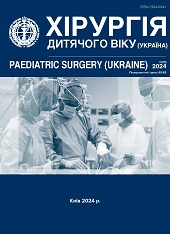The impact of the full-scale war in Ukraine on diagnostic and therapeutic approaches to acute calculous cholecystitis
DOI:
https://doi.org/10.15574/PS.2024.4(85).5258Keywords:
acute calculous cholecystitis, diagnostic approaches, treatment approaches, psychoemotional state of patients, war in UkraineAbstract
During the war, chronic and acute stress are added to the main etiological factors of acute cholecystitis.
Aim - to study the impact of the full-scale war in Ukraine on diagnostic and therapeutic approaches to the treatment of patients with acute calculous cholecystitis.
Materials and methods. 54 patients with acute calculous cholecystitis were treated. An algorithm of therapeutic and diagnostic approaches to acute calculous cholecystitis in the conditions of a full-scale war in Ukraine and negative psycho-emotional impact was developed.
Results. The «well-being» indicator in patients ranged within the low level of psycho-emotional state (25.12-28.18 points). The «activity» and «mood» indicators indicated an average level of psycho-emotional state and ranged from 31.41 to 39.21 points. The period from the onset of an attack of acute calculous cholecystitis to hospitalization of more than 24 hours was observed in 83.3% of cases. Diagnosis of acute calculous cholecystitis during martial law, preparation for surgical intervention required from 6 to 12 hours in 85.2% of patients. A destructive form of inflammation of the gallbladder was observed, which is characteristic of acute calculous cholecystitis. Clinical signs of anemia and the presence of an inflammatory process in the body were diagnosed in patients with acute calculous cholecystitis during wartime. There were no complications in patients with acute calculous cholecystitis who underwent surgery during martial law.
Conclusions. Patients with acute calculous cholecystitis in conditions of full-scale war in Ukraine had a low level of psychoemotional and psychosomatic health. Acute calculous cholecystitis in wartime has important pathogenetic differences and characteristic complications. Laparoscopic cholecystectomy is the gold standard for acute calculous cholecystitis. The study was performed in accordance with the principles of the Declaration of Helsinki. The study protocol was approved by the local ethics committee of the institutions mentioned in the work. Informed consent of the patients was obtained for participation in the study.
The authors declare the absence of a conflict of interest.
References
Boys JА, Doorly MG, Zehetner J et al. (2020). Can ultrasound common bile duct diameter predict common bile duct stones in the setting of acute cholecystitis? Am. J. Surg. 207(3): 432-435. https://doi.org/10.1016/j.amjsurg.2013.10.014; PMid:24581769
Denis F, Mahalli R, Delpierre A, Romagna C, Selimovic D, Renaud M. (2022). Psychobiological Factors in Global Health and Public Health. Int J Environ Res Public Health. 19(11): 6728. https://doi.org/10.3390/ijerph19116728; PMid:35682311 PMCid:PMC9180632
Gomes CA, Junior CS, Di Saverio S, Sartelli M, Kelly MD, Gomes CC et al. (2017). Acute calculous cholecystitis: Review of current best practices. World J. Gastrointest. Surg. 9(5): 118-126. https://doi.org/10.4240/wjgs.v9.i5.118; PMid:28603584 PMCid:PMC5442405
Hall BR, Armijo PR, Krause C, Burnett T, Oleynikov D. (2018). Emergent cholecystectomy is superior to percutaneous cholecystostomy tube placement in critically ill patients with emergent calculous cholecystitis. Am. J. Surg. 216(1): 116-119. https://doi.org/10.1016/j.amjsurg.2017.11.002; PMid:29128102
Kokun OM, Agaev NA, Pishko IO, Lozinska NS, Ostapchuk VV. (2017). Psychological work with servicemen - participants of the anti-terrorist operation at the stage of recovery: Methodical guide. K.: NDC SE of the ZSU: 282.
Pisano M, Allievi N, Gurusamy K et al. (2020). 2020 World Society of Emergency Surgery updated guidelines for the diagnosis and treatment of acute calculus cholecystitis. World J.Emerg. Surg. 15: 61. https://doi.org/10.1186/s13017-020-00336-x; PMid:33153472 PMCid:PMC7643471
Roswiyani R, Kwakkenbos L, Spijker J, Witteman CLM. (2019). The Effectiveness of Combining Visual Art Activities and Physical Exercise for Older Adults on Well-Being or Quality of Life and Mood: A Scoping Review. J Appl Gerontol. 38(12): 1784-1804. https://doi.org/10.1177/0733464817743332; PMid:31640495 PMCid:PMC6820121
Scientific and Methodological Center of VFPO. (2023). Psychological assistance in the conditions of military operations. Psychological Bulletin No. 3. Kyiv: Scientific and Methodological Center of VFPO: 202.
Tarasova V. (2023). The method of studying the characteristics of behavior in stressful situations of teenagers with an unreliable type of attachment. A young scientist. 5: 73-78. https://doi.org/10.32839/2304-5809/2023-5-117-14
Voytenko OV, Tkachuk TL. (2017). Psychological impact of combat stress on military personnel. Medical case. 7: 141-146. https://doi.org/10.31640/LS-2017(7)27
Zlyvkov VL, Lukomska SO, Fedan OV. (2016). Psychodiagnostics of personality in life crisis situations. K.: Pedagogical opinion: 219.
Downloads
Published
Issue
Section
License
Copyright (c) 2024 Paediatric Surgery (Ukraine)

This work is licensed under a Creative Commons Attribution-NonCommercial 4.0 International License.
The policy of the Journal “PAEDIATRIC SURGERY. UKRAINE” is compatible with the vast majority of funders' of open access and self-archiving policies. The journal provides immediate open access route being convinced that everyone – not only scientists - can benefit from research results, and publishes articles exclusively under open access distribution, with a Creative Commons Attribution-Noncommercial 4.0 international license(СС BY-NC).
Authors transfer the copyright to the Journal “PAEDIATRIC SURGERY.UKRAINE” when the manuscript is accepted for publication. Authors declare that this manuscript has not been published nor is under simultaneous consideration for publication elsewhere. After publication, the articles become freely available on-line to the public.
Readers have the right to use, distribute, and reproduce articles in any medium, provided the articles and the journal are properly cited.
The use of published materials for commercial purposes is strongly prohibited.

